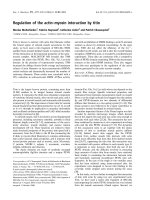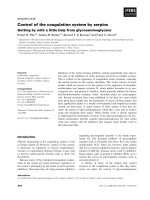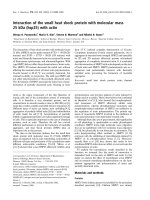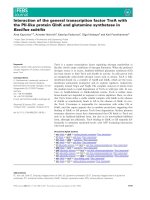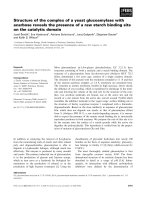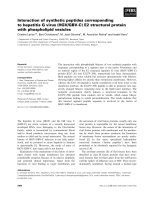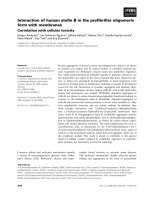Báo cáo khoa học: Interaction of DAPI with individual strands of trinucleotide repeats Effects on replication in vitro of the AATÆATT triplet docx
Bạn đang xem bản rút gọn của tài liệu. Xem và tải ngay bản đầy đủ của tài liệu tại đây (264.8 KB, 7 trang )
Interaction of DAPI with individual strands of trinucleotide repeats
Effects on replication
in vitro
of the AATÆATT triplet
Edoardo Trotta
1
, Nicoletta Del Grosso
1
, Maura Erba
2
, Sonia Melino
2
, Daniel Cicero
2,3,4
and Maurizio Paci
2,3
1
Istituto di Neurobiologia e Medicina Molecolare, Consiglio Nazionale delle Ricerche, Roma, Italy;
2
Dipartimento di Scienze e
Tecnologie Chimiche, Universita
`
di Roma ‘Tor Vergata’, Roma, Italy;
3
INFM sez. B, Roma, Italy;
4
SISSA, Trieste, Italy
The structural changes produced by the minor-groove
binding ligand DAPI (4¢,6-diamidine-2-phenylindole) on
individual strands of trinucleotide repeat sequences were
detected by electrophoretic band-shift analysis and related to
their effects on DNA replication in vitro. Among the 20
possible single-stranded trinucleotide repeats, only the T-rich
strand of the AATÆATT triplet exhibits an observable
fluorescence band and a change in electrophoretic mobility
due to the drug binding. This is attributable to the property
of DAPI that favours folding of the random coil ATT strand
into a fast-migrating hairpin structure by a minor-groove
binding mechanism. Electrophoretic characteristics of AAT,
ACT, AGT, ATG and ATC are unchanged by DAPI,
suggesting the crucial role of TÆT with respect to AÆA, CÆC
and GÆG mismatch, in favouring the binding properties and
the structural features of the ATT–DAPI complexes. Primer
extension experiments, using the Klenow fragment of DNA
polymerase I, demonstrate that such a selective structural
change at ATT targets presents a marked property to stall
DNA replication in vitro in comparison with the comple-
mentary AAT and a random GC-rich sequence. The results
suggest a novel molecular mechanism of action of the DNA
minor-groove binding ligand DAPI.
Keywords: DAPI; trinucleotide repeats; Klenow; DNA
structure; hairpin.
DAPI (4¢,6-diamidino-2-phenylindole) is a DNA minor-
groove binding ligand used largely as a fluorescent dye for
DNA and chromosomes [1]. It interferes with the activity
of DNA processing enzymes involved in regulatory and
structural functions such as DNA polymerase I [2], RNA
polymerases [2–4], topoisomerases [2,5–7], DNA ligase [2],
exonuclease III [2], DNAase I [8] and restriction endonuc-
leases [8], showing varying levels of inhibitory effects [2].
DAPI preferentially binds into the minor-groove of at least
two consecutive AÆT base-pairs [9,10] or TÆTmismatches
flanked by AÆT base-pairs [11]. Quite different binding
mechanisms and a lower affinity with DNA sequences that
contain no adjacent AÆT base-pairs have been reported:
intercalation [12,13], major-groove binding [14] and p,p-
stacking interactions with double-helix ends [15]. It has also
been shown that DAPI favours folding into hairpin
structures of the T-rich strand of AATÆATT trinucleotide
repeat sequences [16]. In this work we investigate the effects
of DAPI on replication in vitro of AATÆATT trinucleotide
repeats in relation to the structural changes induced by the
drug on individual strands of trinucleotide repeats. The
AATÆATT triplet presents a number of biological features
that require further investigation to understand the possible
role of this frequent class of trinucleotide repeat. This triplet
has been reported as the most abundant and polymorphic
trinucleotide repeat in the human genome [17]. Distribution
of the AATÆATT trinucleotide repeat does not appear to
be random in relation to different types of genomic
sequences, but it is frequent in introns and uncommon in
exons, suggesting a possible role in regulating transcription
[18–20]. In contrast to the CG-rich triplet repeats associated
with human diseases, AATÆATT did not show any pausing
of DNA polymerases in the primer extension assay [21] and
has not yet been found associated with human diseases,
although its expansion was observed during DNA replica-
tion in vitro [22,23]. Also unlike other trinucleotide repeats,
the AATÆATT repeat in plasmids shows the unusual
propensity to adopt nonhydrogen-bonded structures, sug-
gesting that it may play a different role in gene regulation
[21]. The AATÆATT repeat also constitutes a binding site for
at least one nuclear protein [24].
The present study demonstrates that DAPI causes a
sequence- and strand-dependent stalling of DNA poly-
merase at AATÆATT trinucleotide repeat regions. This effect
is associated with the strongly selective property of DAPI to
bind and favour the hairpin structure of the T-rich strand of
the AATÆATT trinucleotide repeat. Our results suggest a
novel mechanism of action of DAPI and show the unusual
replication feature of a common class of genomic DNA that
have unknown functions.
Materials and methods
Materials
DNA 18-mers: (AAC)
6
,(AAG)
6
,(AAT)
6
, (ACC)
6
,
(ACG)
6
,(ACT)
6
,(AGC)
6
, (AGG)
6
,(AGT)
6
,(ATC)
6
,
(ATG)
6
, (ATT)
6
, (CCG)
6
,(CCT)
6
,(CGG)
6
,(CGT)
6
,
Correspondence to E. Trotta, Istituto di Neurobiologia e Medicina
Molecolare, Consiglio Nazionale delle Ricerche, Via del Fosso del
Cavaliere 100, 00133 Roma, Italy.
Fax: + 39 064 993 4257, Tel.: + 39 064 993 4567,
E-mail:
Abbreviation:DAPI,4¢,6-diamidino-2-phenylindole.
(Received 5 September 2003, revised 10 October 2003,
accepted 14 October 2003)
Eur. J. Biochem. 270, 4755–4761 (2003) Ó FEBS 2003 doi:10.1046/j.1432-1033.2003.03877.x
(CTG)
6
, (CTT)
6
,(GGT)
6
and (GTT)
6
were used for
evaluating electrophoretic band-shifts induced by DAPI
on trinucleotide repeat sequences.
Three different 70-base templates for primer extension
experiments were synthesized with a common 40-base
sequence at the 3¢-end constituted by a random region with
no adjacent AÆTbases:5¢-GGTCCCAGTCCACTCTGT
CGCCGCACCCTGCGGACCTGCT-3¢ (Fig. 1A,B). The
remaining 30-base sequence at the 5¢-end was distinctive for
each template: (ATT)
10
,(AAT)
10
and 5¢-CAGGTGGA
GCTGTGTCAGTGCCACTGACCC-3¢ for ATT-, AAT-
and random-template, respectively (Fig. 1B). A 5¢-fluoresc-
ein labeled 15-base primer was synthesized that was
complementary to the 41–55 template region.
DAPI (Fig. 1C) and Klenow fragment [3¢fi5¢ exonuc-
lease-deficient (exo-) of Escherichia coli DNA polymerase I]
were purchased from Sigma (St. Louis, MO, USA) and New
England Biolabs Inc. (Beverly, MA, USA), respectively.
Electrophoretic mobility-shift analysis
DAPI-induced electrophoretic mobility-shift analyses were
performed on 12% (w/v) native polyacrylamide gel at 4 °C.
Before gel inoculation, DNA samples were denatured at
90 °C and slowly annealed to room temperature. The
DAPI–DNA complexes were prepared by adding the drug
after DNA annealing. Polyacrylamide gels were stained
with 0.1% (v/v) methylene blue in 0.5
M
sodium acetate.
Samples for comparing binding effects of DAPI on the
18-mer trinucleotide repeat sequences were 150 l
M
DAPI
and 35 l
M
DNA strand in Tris/borate/EDTA buffer.
Primer–template DNA samples were 50 l
M
DAPI and
8 l
M
primer–template in Tris/borate/EDTA buffer.
Fluorescence
Fluorescence spectra were recorded on a SPEX FluoroMax
photon counting spectrofluorometer equipped with a ther-
mostatic cell holder (SPEX Industries Inc., Edison, NJ,
USA). Excitation (350 nm) and emission (448 nm) with
1.5 nm band-pass were used and spectra were corrected for
background signal. The absorbance at the excitation wave-
length was less than 0.03 ([DAPI] ¼ 1 l
M
)makingthe
inner filter effects negligible. The experiments were per-
formed at 37 °C, in 100 m
M
NaCl and 10 m
M
phosphate
buffer at pH 7.00, by adding an increasing amount of DNA
oligomers to the drug solutions up to 2 : 1 (DAPI : tem-
plate) molar ratio.
UV melting experiments
Optical melting experiments were performed on a PC
controlled PerkinElmer Lambda Bio20 double beam spec-
trophotometer equipped with a programmable Peltier
temperature-controlled cell holder. Quartz cuvettes of
1 cm path length were used and closed with a Teflon cap
incorporating the temperature sensor. A layer of paraffin
was also placed on top of the sample solutions to prevent
solvent evaporation. Absorbance of each DNA sample was
0.25 per mL, in 10 m
M
sodium phosphate (pH 7.00) and
100 m
M
NaCl. Complexes were prepared at a base to drug
molar ratio of 3.5. Before thermal melting analysis, samples
were heated to 80 °C for 5 min and then slowly cooled to
the starting temperature of 3 °C. Melting profiles were
acquired by heating samples from 3 °Cto85°Catarateof
1 °CÆmin
)1
and measuring absorbance corresponding to the
maximum around 260 nm at 25 °C. To avoid condensation
of water vapor at low temperatures, the cuvette-holding
chamber was dried by flushing with N
2
gas. The melting
temperature (Tm) was estimated from the maximum of the
first-derivative curve of the absorbance vs. temperature.
Primer extension experiments
Chain extension reactions were catalyzed by the Klenow
fragment of Escherichia coli DNA polymerase I (exo-) in
a volume of 20–40 lL containing 8 l
M
template, 8 l
M
primer, 200 l
M
dNTP, 100 m
M
NaCl and EcoPol buffer
(New England Biolabs). After the addition of primer to the
template solutions, samples were denatured at 94 °Cfor
4 min and slowly annealed to 37 °C. DAPI was added after
primer–template annealing, the solution reactions were
incubated with 2.5 U of Klenow fragment at 37 °Cfor1h
andstoppedwithEDTAtoafinalconcentrationof10m
M
.
Reaction products were desalted by successive dilutions and
filtrations using Centricon YM3 (Millipore) (3000 MW
Fig. 1. DNA sequences and DAPI chemical structure. Schematic rep-
resentation (A) and sequences (B) of the templates and primer used for
chain extension reaction in vitro, catalyzed by Klenow fragment
(3¢fi5¢ exo-) of E. coli DNA polymerase I. The underlined region of
common sequence in (B) represents the primer-complementary region
of the template. (C) Chemical structure of DAPI.
4756 E. Trotta et al. (Eur. J. Biochem. 270) Ó FEBS 2003
cut-off). Finally, samples were lyophilized, suspended in
10 lL of formamide and run at 37 °C and 290 V on a 12%
(w/v) denaturing polyacrylamide gel containing 40% (v/v)
formamide and 7
M
urea. Gels were stained with 0.1% (w/v)
methylenebluein0.5
M
sodium acetate. Gels containing
5¢-fluorescein labeled DNA were analysed by UV transillu-
mination.
Results and discussion
Electrophoretic mobility-shift induced by DAPI
on trinucleotide repeats
Electrophoretic analysis, comparing gel mobility-shift
induced by DAPI on the 20 different individual strands of
trinucleotide repeats, shows an observable increase in
electrophoretic mobility induced by the drug for the triplet
sequence (ATT)
6
only (Fig. 2). As shown previously, such
increased migration is due to the reported ability of the drug
to fold the (ATT)
6
into a hairpin-like structure by a minor-
groove binding mechanism which stabilizes base pairing of
DNA regions containing TÆT mismatches flanked by AÆT
base-pairs [K
a
¼ 3.4 · 10
6
M
)1
considering two binding
sites for (ATT)
6
] [16]. The DAPI–(ATT)
6
complex is also
the only fluorescent band detected in the electrophoretic gel.
It has been reported that binding of DAPI into the minor-
groove of DNA is characterized by a distinctive large
increase of the drug fluorescence quantum yield [25,26] and
by changes in DNA electrophoretic mobility [16,27]. As the
electrophoretic bands of (AAT)
6
,(ACT)
6
,(AGT)
6
,(ATG)
6
and (ATC)
6
do not exhibit such characteristic properties
caused by the drug interaction, our results indicate that
binding of DAPI to two consecutive AÆT base-pairs flanked
by AÆA, GÆGorCÆC mismatches leads to weaker minor-
groove complexes than two consecutive AÆTbase-pairs
flanked by TÆT mismatches. Unexpectedly, even though
intercalation mechanisms have been reported for binding of
DAPI to GC-rich or mixed sequences [12,13], gel mobility
of the GC-rich triplet is unchanged by DAPI and no
fluorescent bands are detected for their DAPI-containing
samples, including those triplets that spontaneously migrate
faster due to their inherent propensity for self-annealing into
hairpin structures: ACG, AGC, CCG, CGG, CGT and
CTG (Fig. 2) [28]. In particular, CGT and CTG triplets,
which self-anneal spontaneously by forming two consecu-
tive Watson–Crick GÆC base-pairs flanked by TÆTmismat-
ches, do not lead to stable complexes with DAPI as in the
case of the ATT triplet. This indicates the crucial role played
by AÆT base-pairs in addition to TÆT mismatches. Therefore,
although our electrophoretic results represent the limited
case of six triplet sequences, the specificity of the observed
effects confirms the higher selectivity of DAPI for the
minor-groove of the ATT-triplet with respect to all the other
individual strands of trinucleotide repeats. Both AÆTand
TÆT base-pairs appear to be necessary conditions for
determining ATT-regions as the most favourable targets
among all the individual strands of trinucleotide repeats.
Binding and conformational properties
of DAPI–template complexes
The binding effects of DAPI on the replication processes of
ATT-triplet sequences were evaluated by comparing prod-
ucts of primer extension reactions by three distinct 70-base
templates containing, respectively (ATT)
10
,(AAT)
10
or a
30-base long GC-rich random sequence at the 5¢ end, as
described in Materials and methods and illustrated in
Fig. 1A,B. The conformational changes induced by DAPI
on the different templates were evaluated to exclude
unexpected binding and structural effects due to the
presence of common primer-complementary and random
sequences. As shown in Fig. 3, DAPI (50 l
M
) does not
induce appreciable changes in the electrophoretic mobility
of AAT- (lane 6) and GC-rich random-templates (lane 2).
Conversely, in the presence of DAPI, the ATT-template
migrates faster than its drug-free form (lanes 4 and 3,
respectively). This increased gel-mobility induced by DAPI
is not merely attributable to the drug interaction per se, as
binding of DAPI normally leads to a reduction in DNA
electrophoretic mobility [16,27]. Moreover, the relatively
low mobility of 1 : 1 AAT-/ATT-template mixture in the
presence of DAPI (Fig. 3, lane 7) safely excludes the
possibility that fast migrating DAPI–ATT-template com-
plex could be constituted by dimeric homoduplex DNA
structures. In contrast, the electrophoretic results account
for a more compact structure of DAPI-bound ATT-
template with respect to its free form, which is consistent
with the previously reported lower mobility of the free
monomeric random coil structure of (ATT)
6
in comparison
with its hairpin conformer bound to DAPI [16].
Binding mechanisms of DAPI and their effects on the
stability of template intramolecular base-pairing were
Fig. 2. Effect of DAPI on the electrophoretic mobility of trinucleotide
repeat DNA sequences. (A) Nondenaturing 12% polyacrylamide gel
migration of the 20 possible triplet repeat strands and their complexes
with DAPI at 4 : 1 drug/template molar ratio. (B) Before gel inocu-
lation, samples were denatured at 90 °C and slowly annealed to room
temperature. Drug–DNA complexes were prepared by adding DAPI
following DNA annealing. Gels were stained with 0.1% (v/v) methy-
lene blue in 0.5
M
sodium acetate. Samples were 35 l
M
DNA and
150 l
M
DAPI in Tris/borate/EDTA buffer.
Ó FEBS 2003 DAPI effects on replication of ATT-triplet (Eur. J. Biochem. 270) 4757
evaluated by fluorescence and UV thermal melting studies.
The addition of ATT-template to DAPI solution determines
drug fluorescence changes that are distinctive of the drug
binding into the minor-groove of the double-helix structure
of AT-rich sequences [25]: the drug fluorescence signal is
strongly increased (8.3-fold at a drug/template molar ratio
of 2 : 1) and the maximum emission is shifted to lower
wavelengths (20 nm) (Fig. 4). The observation of such
distinctive fluorescence properties of the minor-groove
binding mechanism implies the presence in the DAPI–
ATT-template complex of a double-helix structure, in
agreement with the hairpin suggested by the increased gel
mobility of the DAPI–ATT-template complex. In contrast,
addition of AAT- and GC-rich random-template oligomers
to the drug solution causes changes in DAPI fluorescent
properties which are indicative of a weak minor-groove
interaction, GÆC-like intercalation or uncharacterized bind-
ing mechanisms: the shift in the maximum emission at a
2 : 1 drug/template molar ratio was about 12 and 15 nm,
and the increase in the fluorescence intensity was only
2.2- and 1.6-fold for AAT- and random-template, respect-
ively (Fig. 4).
UV thermal melting studies are also consistent with a
double-helix structure of ATT-template complexed with the
drug. Binding of DAPI strongly increases the melting
temperature of the ATT-template from 17 °Cto45°Cas
measured by the shift in sigmoidal melting profiles illustra-
ted in Fig. 5. Consequently, at the Klenow reaction
temperature of 37 °C, the drug-free ATT-template is almost
completely in random coil conformation (Tm ¼ 17 °C)
whereas its DAPI-bound form is prevalently base-paired
(Tm ¼ 45 °C). Moreover, along with a single electropho-
reticbandproducedbytheATT-templateinthepresenceof
DAPI (Fig. 3, lane 4), the observation of a monophasic
thermal transition is consistent with the prevalent presence
of a single DNA structure in the complex, which excludes
the observable presence of dimeric homoduplex structures
Fig. 3. Effect of DAPI on the electrophoretic mobility of DNA tem-
plates. Nondenaturing 12% (w/v) polyacrylamide gel migration of
GC-rich random-template (lanes 1 and 2), ATT-template (lanes 3 and
4), AAT-template (lanes 5 and 6) and 1 : 1 mixture of ATT- and AAT-
template. Samples with (+) and without (–) DAPI are indicated.
Before gel inoculation, samples were denatured at 90 °Candslowly
annealed to room temperature. Drug–DNA complexes were prepared
by adding DAPI following DNA annealing. Gels were stained with
0.1% (w/v) methylene blue in 0.5
M
sodium acetate. Samples were
8 l
M
template–primer and 50 l
M
DAPI in Tris/borate/EDTA buffer.
Fig. 4. Effect of DNA templates on the fluorescence spectrum of DAPI.
DAPI fluorescence spectra in (a) the free form, in the presence of (b)
random-template, (c) AAT-template and (d) ATT-template at 2 : 1
drug/template molar ratio. The experiments were performed at 37 °C,
in 100 m
M
NaCl and 10 m
M
phosphate buffer at pH 7.00. Excitation
(350 nm) and emission (448 nm) with 1.5 nm band-pass were used and
spectra were corrected for background signal.
Fig. 5. Effect of DAPI on the melting curve of ATT-template. Melting
curves of ATT-template in free (- - -) and DAPI-bound forms (––) at a
base/drug molar ratio of 3.5. The DNA solution absorbance was 0.25
per mL in 10 m
M
sodium phosphate (pH 7.00) and 100 m
M
NaCl, and
quartz cuvettes of 1 cm path length were used. Samples were heated at
arateof1°CÆmin
)1
and absorbance was measured corresponding to
the maximum around 260 nm, at 25 °C. Hyperchromicity (%) at the
temperature T °C was given by [A
(T °C)
– A
(3 °C)
]/A
(3 °C)
,whereA
(T °C)
and A
(3 °C)
represent the A
260
at T °Cand3°C, respectively.
4758 E. Trotta et al. (Eur. J. Biochem. 270) Ó FEBS 2003
in addition to the monomeric hairpin. In conclusion, the
spectroscopic and electrophoretic results shows that the
common random GC-rich sequences of the ATT-template
as well as the increased length of its triplet sequence, do not
prevent its (ATT)
10
region from adopting a hairpin-like
structure the equivalent of that induced by DAPI in the
(ATT)
6
oligomer [16].
Primer extension experiments
DNA polymerization studies for evaluating the biological
effects of the binding of DAPI to ATT-, AAT- and random-
template sequences were performed by the Klenow frag-
ment of DNA polymerase I using a 15-base primer
complementary to the 41–55 base-pair region of the
70-base templates reported in Fig. 1. The fully extended
product of Klenow synthesis was 15 bases shorter than the
templates due to the 15 unpaired bases at the 3¢-end of the
templates annealed to the primer (Fig. 1). As shown by
electrophoresis (Fig. 6), at the 16 : 1 DAPI/template molar
ratio, the expected fully extended 55-base product of
Klenow synthesis is present in the lane containing the
reaction products of AAT-template. In contrast at the 16 : 1
DAPI/template molar ratio, DAPI inhibits synthesis of the
55-base product in the ATT-template directed reaction.
Such a sequence-dependent inhibition was effective when
the DAPI/template molar ratio is equal to 8 (DAPI/
(ATT)
2
¼ 1.6), while full-length synthesis products are
observed at a drug/template molar ratio of 4 (DAPI/
(ATT)
2
¼ 0.8), although DAPI/template values of both
4 and 8 present visible products of partial synthesis.
The experiments in Fig. 6 were performed at a constant
template concentration of 8 l
M
and drug concentration
ranging from 8 to 128 l
M
. Such a tight binding condition
(K
a
¼ 3.4 · 10
6
M
)1
considering two binding sites for
(ATT)
6
[16]) strongly shifts the binding equilibrium towards
the bound species. This indicates that DAPI strongly
increases its inhibitory activity when complexes are formed
at a stoichiometric molar ratio of around 1 : 1 with (ATT)
2
target sites.
The observed dependence on template sequence excludes
the possibility that the inhibitory property of DAPI could
only be attributed to a direct interaction of the drug with the
Klenow fragment. A DNA-mediated step correlating with
the different structural and binding characteristics of
DAPI–template complexes is involved. The lanes of Fig. 6
relating to synthesis products using the AAT-template
(8 l
M
), show a weak inhibitory activity of DAPI at high
concentration (128 l
M
), which is more evident at the highest
drug concentration (256 l
M
) (Fig. 7). Such a weak inhib-
itory activity on the AAT-triplet is also sequence-dependent.
At the highest concentration (256 l
M
), DAPI has a very
weak effect on the random-template synthesis appearing to
be almost ineffective on GC-rich sequences (Fig. 7). This
finding is also supported by the observation that the first 10
bases of the GC-rich random sequence of the AAT- and
ATT-templates are copied without any pausing in relation
to the drug-free syntheses. This provides evidence for a
relatively weak sequence-independent inhibitory effect of
DAPI on Klenow activity at our experimental conditions.
Therefore, inhibitory activity of DAPI appears to be
significantly effective only for the AT-rich sequences of the
AAT- and ATT-templates, even though with different
characteristics, as it appears weaker and more homogeneous
along AAT- than ATT-triplet sequences. The weak inhibi-
tion at AAT-triplet sites is attributable to a binding
mechanism that presents spectroscopic characteristics that
are different from those reported for intercalation and
minor-groove binding, indicating minor involvement of
DNA bases [16]. However, the absence of a comparable
inhibitory effect at GC-rich random sequences indicates a
significant direct or indirect involvement of AAT bases in
Fig. 6. Effects of different DAPI/template molar ratios on Klenow
synthesis. Denaturing gel analysis showing the effect of DAPI on
Klenow-catalyzed 5¢-fluorescein labeled primer elongation by ATT-
and AAT-template. Reactions were performed at the constant tem-
plate concentration of 8 l
M
with different DAPI/template molar ratios
(R). Ladder is constituted by 5¢-fluorescein-labeled DNA oligomers
with sequences similar to those expected for the reaction products of
the ATT-template.
Fig. 7. Effect of high DAPI concentration on template-directed Klenow
synthesis. Denaturing gel analysis showing the effect of high DAPI
concentration on the elongation of 5¢-fluorescein labeled primer by
ATT-, AAT- and random-template-directed Klenow synthesis. Sam-
ples were 8 l
M
primer–template and 256 l
M
DAPI. Presence (+) and
absence (–) of DAPI in the reaction solution is indicated. Ladder is
constituted by 5¢-fluorescein labeled DNA oligomers with sequences
similar to those expected for the reaction products of the ATT-
template.
Ó FEBS 2003 DAPI effects on replication of ATT-triplet (Eur. J. Biochem. 270) 4759
the interaction with DAPI. This suggests an efficient
mechanism of single-stranded sequence recognition charac-
terized by small changes in NMR resonances of DNA bases
[16]. It is also relevant that the intercalation mechanism
reported for the binding of DAPI at AÆU[25]andGÆC[12]
sites does not appear to significantly affect Klenow activity
catalyzed on the AAT- and GC-rich random-templates. The
synthesis was stalled by DAPI on the ATT-bearing template
giving rise to a prevalent product of about 31–33 bases
(Fig. 7) indicating that, in addition to the initial 10-base
random sequence, at least 6–8 bases of ATT-region are
copied by the Klenow fragment before it stalls. In other
words, the ATT motif itself does not appear to be sufficient
to block DNA synthesis by DAPI, suggesting an effect by
different structural features along the (ATT)
10
sequence
caused by the drug interaction. As shown above, DAPI
induces the formation of hairpin structures on the ATT- but
not on the AAT- and GC-rich random-templates. In
addition, it has been reported previously that long tracts
of CTGÆCAG repeats, which have the propensity to fold
into stable hairpin structures [29–31], block the replication
fork in E. coli [32] and cause a pause in DNA synthesis
in vitro [33]. These findings suggest that the stall of Klenow
progression observed in the present study could be attrib-
uted to the (ATT)
10
region (located at the 5¢-end of the
ATT-template) folding into a hairpin-like structure. The
double helix of the hairpin stem, stabilized by the binding of
DAPI into the minor-groove of AÆTandTÆTbase-pairs,
appears to be responsible for stalling the Klenow fragment.
As AÆAandTÆT mismatches cause similar destabilizing
effects on the double helix structure [34–36], the dissimilar
influence of DAPI on the Klenow catalyzed replication of
AAT- and ATT-containing sequences can only be attrib-
uted to the more favourable characteristic of the TÆT minor-
groove than the AÆA minor-groove, in the binding of DAPI
[16]. In conclusion, the main cause of the strong inhibitory
effect of DAPI on DNA replication in vitro reported in this
work appears to be linked to the propensity of the drug to
stabilize the double helix structure by favourable electro-
static, H-bonds and van der Waals contacts with the DNA
minor-groove surface [11,16]. Although it should be men-
tioned that the drug could affect other cellular processes at
the conditions necessary for stalling DNA polymerase
progression, the results nevertheless suggest a novel struc-
tural model for the molecular mechanism of the action of
minor-groove binding ligands.
Conclusion
This study reports the effect of the classical minor-groove
binding ligand DAPI on AATÆATT trinucleotide repeat
replication in vitro, catalyzed by the Klenow fragment of
DNA polymerase I. The high affinity and structural
changes selectively produced by DAPI on the ATT-strand
of the AATÆATT trinucleotide repeat are associated with
the stalling of Klenow progression along the ATT-template
sequence. This draws attention to the biological relevance
of high affinity drugs with structural effects on single-
stranded DNA and RNA. The main genetic processes such
as replication, transcription and translation involve indi-
vidual strands of DNA and RNA, emphasizing the
importance of studies that attempt to clarify the relation-
ship among binding, structural and biological aspects
relating to this conformational class of nucleic acids.
Particularly in the case of trinucleotide repeats, the
secondary structures of individual strands are considered
to be the main cause of their expansion, and are associated
with a number of human genetic diseases [28]. In
particular, the formation of stable intramolecular hairpins
appears to be the most probable cause of CAGÆCTG and
CGGÆCCG expansion, by favouring slippage of DNA
strands during DNA replication. We have found previ-
ously that the spontaneous hairpins reported for the T-rich
strand of CAGÆCTG triplets are similar to those induced
byDAPIandHoechstontheT-richstrandofAATÆATT
trinucleotide repeats [16]. The present work shows that
such a structural affinity is associated with a comparable
ability to influence DNA polymerase activity, given that
tracts of CAGÆCTG triplets can affect DNA replication
in vivo [32] and can be sites of pausing of DNA synthesis
in vitro [33]. The CAGÆCTG triplet repeats present
additional biological characteristics that have been attrib-
uted to its propensity to fold into hairpin structures,
suggesting further potential biological properties of DAPI-
induced hairpins: regions of CAGÆCTG triplets are tran-
scribed significantly slower than random sequences [37]
and can elude cellular mechanisms designed to repair
DNA [38]. Moreover, because it has emerged that specific
DNA sequences within introns can regulate transcription
[19,20], the prevalent location of ATT triplet repeats within
introns in the human genome [18] suggests strongly that
binding of DAPI to ATT-bearing genomic targets may
influence the transcriptional processes.
In conclusion, the results reported in this work suggest a
novel molecular mechanism of action of the classical minor-
groove binding ligand DAPI. This property is associated
with the ability of the drug to bind and stabilize folded
structures in ATT-triplet sequences, by favourable and
selective interaction with the minor-groove of AÆTandTÆT
base-pairs. The molecular mechanism proposed in this work
may help in designing new minor-groove binding ligands
with sequence-selective activity on DNA replication.
Acknowledgements
We thank Fabio Bertocchi for his technical assistance. This work is
supportedinpartbytargetprojectÔBiotecnologiaÕ of Italian CNR.
References
1. Kapuscinski, J. (1995) DAPI: a DNA-specific fluorescent probe.
Biotech Histochem 70, 220–233.
2. Parolin, C., Montecucco, A., Chiarocchi, G., Pedrali-Noy, G.,
Valisena, S., Palumbo, M. & Palu` ,G.(1990)Theeffectofthe
minor groove binding agent DAPI (4,6-diamidino-2-phenyl-
indole) on DNA-directed enzymes: an attempt to explain inhibi-
tion of plasmid expression in Escherichia coli. FEMS Microbiol.
Lett. 68, 341–346.
3. Straney, D.C. & Crothers, D.M. (1987) Effect of drug–DNA
interactions upon transcription initiation at the lac promoter.
Biochemistry 26, 1987–1995.
4. Chiang, S Y., Welch, J., Rauscher, F.J. & Beerman, T.A. (1994)
Effects of minor groove binding drugs on the interaction of TATA
box binding protein and TFIIA with DNA. Biochemistry 33,
7033–7040.
4760 E. Trotta et al. (Eur. J. Biochem. 270) Ó FEBS 2003
5. Storl, K., Storl, J., Zimmer, C.H. & Lown, J.W. (1993) Minor-
groove binders are inhibitors of the catalytic activity of DNA
gyrases. FEBS Lett. 317, 157–162.
6. Woynarowski, J.M., McHugh, M., Sigmund, R.D. & Beerman,
T.A. (1989) Modulation of topoisomerase II catalytic activity by
DNA minor groove binding agents distamycin, Hoechst 33258,
and 4¢,6-diamidine-2-phenylindole. Mol. Pharmacol. 35, 177–182.
7. McHugh, M.M., Woynarowski, R.D. & Beerman, T.A. (1989)
Effect of minor groove binding drugs on mammalian topo-
isomerase I activity. Biochem. Pharmacol. 38, 2323–2328.
8. Parolin, C., Zanotti, G. & Palu` , G. (1995) A model for the
sequence-dependent DNA binding of 4¢,6-diamidino-2-phenyl-
indole (DAPI). Biochem. Biophys. Res. Commun. 208, 332–338.
9. Wilson, W.D., Tanious, F.A., Barton, H.J., Jones, R.L., Fox, K.,
Wydra, R.L. & Strekowski, L. (1990) DNA sequence dependent
binding modes of 4¢6-diamidino-2-phenylindole (DAPI). Bio-
chemistry 29, 8452–8461.
10. Trotta, E., D’Ambrosio, E., Del Grosso, N., Ravagnan, G., Cirilli,
M. & Paci, M. (1993)
1
H NMR study of [d(GCGATCGC)]
2
and
its interaction with minor groove binding 4¢,6-diamidino-2-pheny-
lindole. J. Biol. Chem. 268, 3944–3951.
11. Trotta, E. & Paci, M. (1998) Solution structure of DAPI selectively
bound in the minor groove of a DNA TÆT mismatch-containing
site: NMR and molecular dynamics studies. Nucleic Acids Res. 26,
4706–4713.
12. Wilson, W.D., Tanious, F.A., Barton, H.J., Strekowski, L. &
Boykin, D.W. (1989) Binding of 4¢,6-diamidino-2-phenylindole
(DAPI) to GC and mixed sequences in DNA: intercalation of a
classical groove-binding molecule. J. Am. Chem. Soc. 111, 5008–
5010.
13. Trotta, E., D’Ambrosio, E., Ravagnan, G. & Paci, M. (1995)
Evidence for DAPI intercalation in CG sites of DNA oligomer
[d(CGACGTCG)]
2
:a
1
HNMRstudy.Nucleic Acids Res. 23,
1333–1340.
14.Kim,S.K.,Eriksson,S.,Kubista,M.&Norde
´
n, B. (1993)
Interaction of 4¢,6-diamidino-2-phenylindole (DAPI) with
poly[d(G-C)
2
] and poly[d(G-m
5
C)
2
]: evidence for major groove
binding of a DNA probe. J. Am. Chem. Soc. 115, 3441–3447.
15. Trotta, E., D’Ambrosio, E., Ravagnan, G. & Paci, M. (1996)
Simultaneous and different binding mechanisms of 4¢,6-diami-
dino-2-phenylindole to DNA hexamer (d(CGATCG))2. A
1
H
NMR Study. J. Biol. Chem. 271, 27608–27614.
16. Trotta,E.,DelGrosso,N.,Erba,M.&Paci,M.(2000)TheATT
strand of AATÆATT trinucleotide repeats adopts stable hairpin
structures induced by minor-groove-binding ligands. Biochemistry
39, 6799–6808.
17. Gastier, J.M., Pulido, J.C., Sunden, S., Brody, T., Buetow, K.H.,
Murray, J.C., Weber, J.L., Hudson, T.J., Sheffield, V.C. & Duyk,
G.M. (1995) Survey of trinucleotide repeats in the human genome:
assessment of their utility as genetic markers. Hum. Mol. Genet. 4,
1829–1836.
18. Stallings, R.L. (1994) Distribution of trinucleotide microsatellites
in different categories of mammalian genomic sequence: implica-
tions for human genetic diseases. Genomics 21, 116–121.
19. Lozano, G. & Levine, A.J. (1991) Tissue-specific expression of p53
in transgenic mice is regulated by intron sequences. Mol. Carci-
nogen. 4, 3–9.
20. Brinster, R.L., Allen, J.M., Behringer, R.R., Gelinas, R.E. &
Palmiter, R.D. (1988) Introns increase transcriptional efficiency in
transgenic mice. Proc. Natl Acad. Sci. USA 85, 836–840.
21. Ohshima, K., Kang, S., Larson, J.E. & Wells, R.D. (1996)
TTA.TAA triplet repeats in plasmids form a non-H bonded
structure. J. Biol. Chem. 271, 16784–16791.
22. Lyons-Darden, T. & Topal, M.D. (1999) Effects of temperature,
Mg
2+
concentration and mismatches on triplet-repeat expansion
during DNA replication in vitro. Nucleic Acids Res. 27, 2235–
2240.
23. Lyons-Darden, T. & Topal, M.D. (1999) Abasic sites induce tri-
plet-repeat expansion during DNA replication in vitro. J. Biol.
Chem. 274, 25975–25978.
24. Richards,R.I.&Holman,K.,Yu,S.&Sutherland,G.R.(1993)
Fragile X syndrome unstable element, p(CCG)n, and other simple
tandem repeat sequences are binding sites for specific nuclear
proteins. Hum. Mol. Genet. 2, 1429–1435.
25. Tanious, F.A., Veal, J.M., Buczak, H., Ratmeyer, L.S. & Wilson,
W.D. (1992) DAPI (4¢,6-diamidino-2-phenylindole) binds differ-
ently to DNA and RNA: minor-groove binding at AT sites and
intercalation at AU Sites. Biochemistry 31, 3103–3122.
26. Eriksson, S., Kim, S.K., Chiarocchi, G., Kubista, M. & Norden,
B. (1993) Binding of 4¢,6-diamidino-2-phenylindole (DAPI) to AT
regions of DNA: evidence for an allosteric conformational change.
Biochemistry 32, 2987–2998.
27. Larsson, A., Akerman, B. & Jonsson, M. (1996) DAPI staining of
DNA: effect of change in charge, flexibility, and contour length on
orientational dynamics and mobility of the DNA during agarose
gel electrophoresis. J. Phys. Chem. 100, 3252–3263.
28. Mitas, M. (1997) Trinucleotide repeats associated with human
disease. Nucleic Acids Res. 25, 2245–2254.
29. Gacy, A.M., Goellner, G., Juranic, N., Macura, S. & McMurray,
C.T. (1995) Trinucleotide repeats that expand in human disease
form hairpin structures in vitro. Cell 81, 533–540.
30.Mitas,M.,Yu,A.,Dill,J.,Kamp,T.J.,Chamber,E.J.&
Haworth, I.S. (1995) Hairpin properties of single-stranded DNA
containing a GC-rich triplet repeat: (CTG)
15
. Nucleic Acids Res.
23, 1050–1059.
31. Chen, X., Mariappan, S.V.S., Catasti, P., Ratliff, R., Moyzis,
R.K., Laayoun, A., Smith, S.S., Bradbury, E.M. & Gupta, G.
(1995) Hairpins are formed by the single DNA strands of the
fragile X triplet repeats: structure and biological implications.
Proc.NatlAcad.Sci.USA92, 5199–5203.
32. Samadashwily, G.M., Raca, G. & Mirkin, S.M. (1997) Tri-
nucleotide repeats affect DNA replication in vivo. Nat. Genet. 17,
298–304.
33. Kang, S., Ohshima, K., Shimizu, M., Amirhaeri, S. & Wells, R.D.
(1995) Pausing of DNA synthesis in vitro at specific loci in CTG
and CGG triplet repeats from human hereditary disease genes.
J. Biol. Chem. 270, 27014–27021.
34. Aboul-ela, F., Koh, D., Tinoco, I. & Martin, F.H. (1985) Base-
base mismatches. Thermodynamics of double helix formation for
dCA3XA3G + dCT3YT3G (X, Y ¼ A,C,G,T). Nucleic Acids
Res. 13, 4811–4824.
35. Werntges, H., Steger, G., Riesner, D. & Fritz, H.J. (1986)
Mismatches in DNA double strands: thermodynamic parameters
and their correlation to repair efficiencies. Nucleic Acids Res. 14,
3773–3790.
36. Ikuta, S., Takagi, K., Wallace, R.B. & Itakura, K. (1987) Dis-
sociation kinetics of 19 base paired oligonucleotide-DNA duplexes
containing different single mismatched base-pairs. Nucleic Acids
Res. 15, 797–811.
37. Parsons, M.A., Sinden, R.R. & Izban, M.G. (1998) Transcrip-
tional properties of RNA polymerase II within triplet repeat-
containing DNA from the human myotonic dystrophy and fragile
Xloci.J. Biol. Chem. 273, 26998–27008.
38. Moore,H.,Greenwell,P.W.,Liu,C P.,Arnheim,N.&Petes,
T.D. (1999) Triplet repeats form secondary structures that escape
DNA repair in yeast. Proc. Natl Acad. Sci. USA 96, 1504–1509.
Ó FEBS 2003 DAPI effects on replication of ATT-triplet (Eur. J. Biochem. 270) 4761

